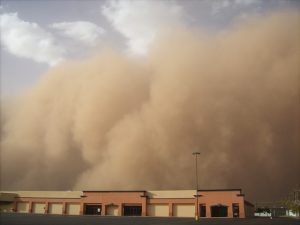Like drizzly gray skies are to the Pacific Northwest, so are dusty skies to West Texas. No, it doesn’t rain all the time in Seattle, nor is it always dusty in Odessa-Midland. But both have earned their monikers for a reason.

As if we don’t have enough of our own, the Sahara has contributed a high volume of dust to our skies lately. Houston got hit harder than we did, but the constant haze has brought to life the term “brassy sky.” I think I first encountered the term in a Louis L’Amour western. But it wasn’t until I came here that I could really say, “That’s a brassy sky.” Bright, with a reddish-gold haze tinting the horizon, then graduating to an azure above, like an inverted bronze or brass bowl with an enameled center. It’s been that way for days.
Smoke from forest fires can be similar, but is usually browner and/or grayer, and more dense. Not that we don’t get heavy dust storms like that, too, but they’re more home-grown. You’ve probably seen pictures of a haboob before: those billowing walls of dust that pile hundreds — sometimes thousands — of feet up and swallow everything in their path. Here, they usually come from a Blue Norther.
A high pressure cold front moves in from the north. Temperatures can drop 50+ degrees in an hour. The winds generated by such a front pick up the red dust, sand and soil from the Southern Plains and moves it through the Texas panhandle to us across hundreds of miles. Visibility shrinks to that of a brown fog, often less than 1/4 of a mile. But the wind howls like a blizzard. If you’re caught out in it, you get grit everywhere — teeth, ears, eyes, nose, underwear — places you’d never have thought possible. Is seeps in through even the most weather-sealed doors, windows and vents. Generally, it can take 24-36 hours for the dust to settle, and the brassy sky effect is there for a day or so.

Most of the time, though, our dust is local. This is sagebrush, greasewood and oilfield country. There’s lots of traffic on dirt or caliche (a type of limestone) roads, lots of construction during the boom, and an arid climate that keeps the scrub from holding the soil. These all contribute to the dust in the air. Sometimes we’ll get enough moisture for isolated thunderstorms, and then we’ll get mini-dust storms and even brown rain.
Yes, brown rain. The storm cells will generate very localized high winds as they move through. Sometimes that dust gets pulled into the cloud and attaches to the rain, sometimes the rain just gathers it as it falls and leaves muddy drops on your windshield. Virga is common with those small storms. That’s where you see the streaks coming from the clouds and disappearing before they ever reach the ground. The air below the cloud is too dry, and the rain evaporates before it can reach the ground.
But on those mornings when the dust, wind and humidity are all low, the crystalline sky rivals any I’ve seen outside of the mountains.